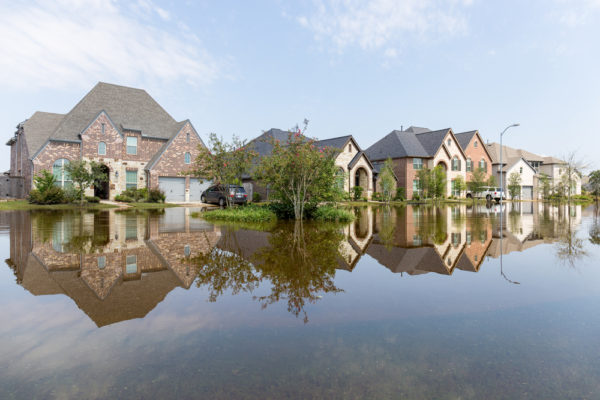It’s sink or swim time for the National Flood Insurance Program

Houses in Houston suburb flooded from Hurricane Harvey 2017
In 2017 there were seventeen named storms that ended up hitting the United States. These storms caused over $200 billion in damage, which makes it a record setting year and much of the damage was caused by flooding due to heavy rains that continued for days in some areas.
While private insurance companies stepped up to covered damage that was done by wind and other factors, all of the flood damage fell to the National Flood Insurance Program (NFIP), which was already deeply in debt.
Flood damage is excluded from basically all private insurance plans so homeowners must have a separate flood insurance policy, which are issued by the NFIP. Currently, the NFIP is roughly $25 billion in debt, which made this storm season particularly hard on the government funded program.
Problems with the NFIP Go Way Back
The problems with the NFIP go all the way back to 1968 when the program was first created. While the program was well intentioned it has never properly funded and it did not deter people from building homes in flood prone areas.
The NFIP was created when the federal government realized that private insurance companies were refusing or financially unable to write flood insurance policies in certain areas at a reasonable price point so the government stepped in to subsidize the cost of flood insurance coverage. While a well intended move, it quickly proved to be financially disastrous.
The government mapped out Special Flood Hazard Areas that highlighted flood prone areas and they mistakenly assumed that these maps would discourage people from living or building in these areas. Unfortunately, that did not turn out to be the case.
Water loving homeowners not only continued to live in these areas, but people built new homes in flood prone areas and took advantage of the affordable flood insurance rates provided by the NFIP. Rates that were nowhere near realistic when it came to the actual risk these properties presented.
In addition, as homes in these areas flooded numerous times they were rebuilt on the same spot, resulting in multiple payouts on the same property over the years. All of this put the NFIP program into debt pretty quickly.
As of this year the NFIP insures roughly 5.5 million homes across the country and a certain percentage of them continue to be repetitive loss properties, which are repaired or rebuilt repeatedly using subsidized NFIP policies. There are no regulations in place that prevent these homes from being insured by NFIP policies even after numerous flood incidents.
According to experts, NFIP policies do not accurately reflect the risk these properties present and changes have to be made to keep the program afloat.
No Easy Answers
There is no easy solution to the problem without some homeowners paying much higher premiums, rates that accurately reflect the actual property risk. In addition, congress does not seem to have the stomach to properly fix the issue.
In 2012, the Biggert-Waters Flood Insurance Reform Act was passed which scaled back subsidies for flood insurance policies on second homes and houses that were damaged repeatedly by flooding. The goal of the legislation was to increase premiums for 400,000 properties that received the biggest subsidies until the premium reflected the actual risk of the property.
Unfortunately, congress folded when homeowners complained about rising rates, some saw premium increase of 25 percent per year. The Biggert Waters Act was quickly repealed.
Recent ideas to shore up NFIP include continuing coverage for current policyholders but not issuing new homeowners who move into these areas. Predictably, this idea has been condemned by homebuilders and homeowners who live in these areas.
While there are no easy answers, unless lawmakers toughen up and impose new restrictions and raise premiums, the program is doomed to fail.
For questions about flood insurance or a flood insurance policy, please call us at 888-620-1954.
